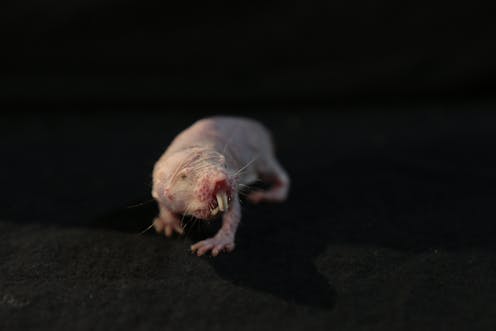Naked mole rat genes could hold the secret to pain relief without opioids
With the opioid crisis there is no doubt that physicians need safer, nonaddictive pain killers. Now new insights on how to create these are coming from an unlikely source: the naked mole rat.

Anyone with an annoying roommate story knows that a difficult living situation can change you in many ways. Now, imagine that instead of just eating all of your food in the refrigerator, that annoying roommate could actually cause genetic changes designed to make the “future you” more tolerant of their behavior. Does it sound too good to be true? Well, this is exactly what has happened in the case of some African rodent species that live in harsh conditions characterized by acidic air, stinging insects and pungent food sources.
I am a behavioral geneticist studying how genes and the environment interact to determine the risk for chronic pain. My goal is to harness that knowledge to develop novel therapies to better treat pain without the need for opioids. Opioids are a powerful tool to treat pain, particularly acute pain, but they do not precisely target a specific pain mechanism or signal. Instead, opioids primarily act to decrease the ability of cells to transmit pain messages without actually turning off the message itself.
I was struck by this work on naked mole rats because these creatures have evolved insensitivity to very specific types of painful stimuli. This occurs as a result of subtle differences in gene activity and protein structure, rather than deletions or mutations of genes.
It is becoming more widely accepted that these types of differences in gene activity may explain individual differences in human pain sensitivity and in risk for the development of chronic pain. More importantly, if pain researchers understand these processes in these rodents and translate this work into humans, it would naturally lead to innovative methods for safe and effective pain relief.
Stinky burrows drive evolution of pain tolerance
Naked mole rats, Heterocephalus glaber, are native to East Africa and live in densely populated underground burrows. Inside these burrows, the exhaled carbon dioxide levels are so high that the air becomes so acidic that it would cause a painful burning sensation in the nose, eyes and exposed skin of most mammals.
But the naked mole rat is completely insensitive to these high acid conditions, making it extremely tolerant of all that togetherness. What’s more is that these rodents are also insensitive to capsaicin, the chemical responsible for the burning pain of chili peppers.

New research led by Gary Lewin, a sensory system physiologist in Berlin, Germany, reveals that naked mole rats aren’t the only African rodents that have evolved to tolerate tough living conditions. Through a comparison of nine closely related African rodent species, Lewin’s team showed that four were completely insensitive to at least one of three painful substances: acid, capsaicin or AITC, which is the active ingredient in mustard oil.
All of these stimuli cause different types of pain. The acid is the one that mimics the high carbon dioxide in the burrow. The capsaicin and mustard oil (AITC) – which cause a burning pain – are found in typical foods that the naked mole rats eat. But each cause pain through a different biochemical pathway.
Implications for the opioid crisis
The evidence points to pain insensitivity to acid, capsaicin and AITC all evolving separately in related rodent species. But in the end these adaptations help these rodents survive and thrive in their hot, dark and acidic environments. Without major alterations in structure and function of the pain-sensing pathway in their bodies, these rodents have evolved multiple ways of reducing their sensitivity to common painful stimuli they encounter daily. In short, these related species of rodents found more than one way to become uber-tolerant to their living conditions and their roommates.
In my mind, understanding the molecular changes that allow the naked mole rat and its relatives to become resistant to certain types of pain has implications far beyond the rodent roommate market. They directly point to novel therapeutic strategies that can be developed to treat pain in humans by selectively engaging or blocking processes involved in specific types of pain sensitivity.
With the dueling epidemics of chronic pain and the opioid crisis, precision medicine alternatives offer hope for those with difficult to manage pain by attacking the “cause” of the pain and offering a lower risk of side effects including misuse, abuse and addiction.
Erin Young receives funding from National Institutes of Health.
Read These Next
From truce in the trenches to cocktails at the consulate: How Christmas diplomacy seeks to exploit s
World leaders like to talk up peace at Christmastime. But alongside the tales of seasonal breaks in…
How to reduce gift-giving stress with your kids – a child psychologist’s tips for making magic and a
Depending on family circumstances and a child’s personality type, gift giving runs the gamut of fun…
Autocracies in transition: In 2025, Cameroon and Tanzania rulers clung to power — but look more vuln
The countries, whose respective leaders recently won widely disputed elections, offer contrasting examples…






